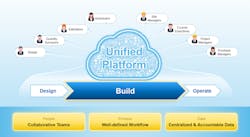Growth in the global construction industry has stagnated over the past 20 years when compared to other industries. If construction’s productivity had grown at the same rate as the global economy the added value would equate to $1.6 trillion. Construction is also one of the least digitized industries and invests far less in IT than other sectors. While this presents a challenge, it also provides the industry with an opportunity to do things differently. As the industry prepares for a digital transformation, its people, data, and processes must be top of mind.
First pillar: empowering people
It’s people working together that create great buildings – the industry cannot succeed without a strong workforce. We need to ensure that people have all the tools they need to thrive. Here are two areas to focus on:
- Help people adapt to new technology, new thinking, and new ways of working.
Change in any organization can face resistance, so it’s important to keep all stakeholders in the loop early in the technology selection process. Getting their feedback will be beneficial in helping you select the right solution for your organization and will help them feel more invested in the process, and thus more likely to embrace the changes.
When implementing new technology, it is critical to dedicate sufficient time and resources to the process. Adopting new software not only creates a shift in workflows but also a shift in ways of thinking and working. There will be a learning curve but with proper training and some patience, the pay-off is well worth the effort.
- Help people communicate and collaborate efficiently with a true cloud platform.
In today’s environment, cloud and mobile solutions have become a vital strategic imperative. Construction firms that are still using fragmented, disconnected tools will increasingly find themselves at a disadvantage when competing with peers who are using connected solutions supported by data and business intelligence. Implementing a true cloud platform enables teams to be more data-driven, more connected, and more collaborative, resulting in increased productivity and performance.
Second pillar: connected data
The data-based world is moving exponentially, but the way we think, and the way traditional organizations operate are still linear. As a result, most industries find themselves in a mode of complacency, so when an exponential trend appears they are immediately disrupted. Unfortunately, when this occurs it is often too late to respond, but it doesn’t have to be this way.
Technology enables construction businesses to be more proactive and strategic by unlocking the true value of their data. When it comes to data, three things to look for when selecting a technology solution are a central database, real-time access, and an effective dashboard.
- Cloud-based central database. Data that is collected in silos cannot provide a complete picture. It is crucial to have a cloud-based central database at the core of a solution to gain critical business insights.
- Real-time access. Most construction projects today run in a reactive nature due to a lack of real-time data integration. Real-time access to information allows teams to course-correct before it’s too late and ensures that teams are always making decisions based on the right information.
- Effective Dashboard. With so much data available it can be difficult to keep track of what’s most important. An effective dashboard provides a snapshot of key business metrics and allows users to quickly drill down to relevant data and insights when further analysis is needed.
Third pillar: connected processes
With so many moving parts and unknown variables, construction projects often veer off course. Change orders, budget overruns, project delays, and other challenges are difficult to navigate but having a connected digital platform can drastically reduce the impact of these challenges.
Imagine starting in the planning phase with all relevant stakeholders collaborating on a connected platform. This would mean that the instance a design is changed, changes in quantity takeoffs and costs would be reflected, or when a project owner suggests changing course, the effect on cost, time, and the final outcome would be calculated instantly. This is the power of connectivity.
The critical step? Connecting all people, data, and processes.
When these three pillars are not integrated, teams are unable to fully comprehend the impact of any change, any action, and any decision on scheduling, budget, and timelines. This puts a project (and business) at risk. Implementing a cloud-based unified platform ensures all people, data, and processes are connected and allows your stakeholders to collaborate easily, solve problems quickly, and create value effectively. This drives the kind of growth and productivity gains of a successful digital transformation.
Digitally Transform with MTWO Construction Cloud
MTWO is the enterprise 5D BIM solution for contractors, developers and business owners who want to enhance every aspect of their digitalization journey. Featuring next-generation technologies including building information modeling, business intelligence (BI), and cloud functionality; MTWO is designed to connect people, processes, and data for streamlined workflows and improved collaboration and productivity.
Learn More:
Download our White Paper to learn how an integrated and scalable platform helps construction enterprises adapt to changes to ensure a sustainable future.
https://www.softwareone.com/en-us/now/local/noram/futureproof-your-construction-business-rb

